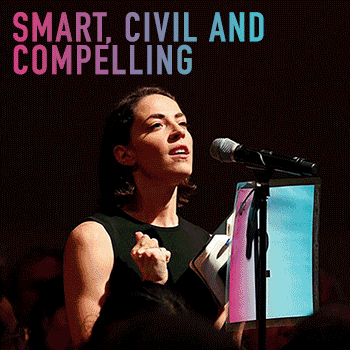How to spot an ototoxic leader

How to spot an ototoxic leader
Opinion + AnalysisBusiness + Leadership
BY John Neil The Ethics Centre 13 AUG 2019
We all know about toxic leaders. There are plenty of them around. Some are especially skilled with the ability to use their words to grind down anyone they perceive as a threat.
I call these leaders ototoxic – named after the medical description of drugs that cause adverse reactions to the ears’ cochlea or auditory nerves.
Ototoxicity is a distinctive quality of a poor leader, who can leave a trail of damage.
Ototoxic leaders betray themselves by a number of logical fallacies – hallmarks of their communication style. US President Donald Trump has given us plenty of examples during his presidency.
They play the person not the argument
The ototoxic leader will go after a person’s character or pick on a personal trait. They take aim at anything personal, but will avoid addressing the logical merits of the argument. This is known as an ad hominem fallacy.
Donald Trump critiqued fellow Republicans – “Lyin’ Ted” (Cruz), “Lil’ Marco” (Rubio), “Low Energy Jeb” (Bush). There were also repeated references to “Crooked Hillary”. He repeatedly accused opponents of being “too aggressive”, (usually a woman) or “not forceful enough” (usually a man), or in the case of “Lil’ Bob” Corker, of not being “tall” enough to be taken seriously.
They use straw-man arguments
An ototoxic leader will also exaggerate, or blatantly fabricate, an opposing point of view. This allows them to position their perspective as more reasonable and practical. In the third presidential debate before his election, Trump accused Hillary Clinton of advocating an open border policy, misquoting comments she made in relation to free trade. In a climate of widespread national hostility towards immigration, the border wall seemed to many as the more reasonable option.
In the workplace, an ototoxic leader will use overblown rhetoric to belittle someone else’s initiative, exaggerating potential cost overruns or overstating other risks in order to then position their proposal as the more reasonable one.
They appeal to hypocrisy
This defensive strategy turns an initial criticism back on the accuser. Trump used this rhetorical flourish during his presidency after refusing to face criticisms that he didn’t take a position on the violence following the Charlottesville rally. Rebutting the criticisms of neo-Nazis and the Ku Klux Klan, Trump maintained that ‘many others’ had also done bad things, implying they were equally culpable.
In the workplace, an ototoxic leader can often be heard defending their actions using the appeal to hypocrisy. “You think I’m aggressive? What about that meeting last week when you didn’t agree with me? You were just as bad, if not worse!”
They use the firefighter arsonist tactic
Named after the rare syndrome where firefighters light fires intentionally only to later arrive as a hero to put it out, the ototoxic leader will overly dramatise a potential problem, at the same time pointing the finger of blame at others for causing it. Once the situation reaches a critical mass, the ototoxic leader will then step in with a last-minute solution, ‘saving the day’.
Trump is well versed in this tactic. Stoking anti-Muslim sentiment as early as March 2011 with his calls for then President Obama to show his birth certificate and trading on unfounded ‘birther’ claims, Trump proceeded to inflame fears throughout the election campaign. He threatened the mass deportation of Syrian asylum seekers while promising to create a database of all Muslims in the US, along with making false claims of seeing ‘thousands and thousands’ of people in New Jersey celebrating the collapse of the World Trade Centre Towers in 2001. Trump stepped in to solve the ‘problem’ by signing his two travel bans within the first 100 days of his tenure.
More recently, Trump repeatedly covered himself in glory after meeting Kim Jong-un at their historic first summit in June 2018. Mere months after painting Kim as “Little Rocket Man” who, according to Trump posed the greatest threat to Western civilisation and was enabled by his predecessors who “should have been handled a long time ago”, following the summit Trump celebrated the “success” of the meeting. He waxed lyrical about the leaders “tremendous” relationship, including the beautiful “love letters” he received from the North Korean dictator in the lead up to the summit, while going on to extol the virtues of Kim, including his “great personality”, his sense of humour, intelligence and his negotiation abilities. Following the script of the hero who rides in to save the day, Trump tweeted that “everybody can now feel much safer than the day I took office…there is no longer a nuclear threat from North Korea.”
In the workplace, the ototoxic leader will spark a flame of disquiet around a project or strategy then proceed to escalate concerns – often through back channel politics – before presenting a grand ‘solution’ that saves the day.
Passive and aggressive
Ototoxic leaders can be aggressive or passive. The actively toxic communicator, who uses aggressive and intimidating language to subordinate others, can be bombastic, opinionated and openly dismissive of those who have different views. Their default mode of questioning almost exclusively involves closed questions (yes or no). Their inability to be open and listen to other’s views is usually a symptom of their lack of empathy.
The passive ototoxic leader is no less poisonous. In one-on-one settings, they are an impatient listener and will quickly interrupt their interlocutor in order to express their own view, often cutting the other person off in mid-sentence.
This ototoxic leader will tend to become frustrated in meetings if the consensus view is running contrary to theirs, to the point they will actively disengage from what’s going on in the room. They will resist all attempts to re-engage them by looking to shut down the conversation wherever possible.
Energy suckers
The net effect of the ototoxic leader’s tactics and communication style is to de-energise those they come into contact with.
Research shows that these de-energising ties have a disproportionate impact on an organisation’s culture. They are a ‘toxicity multiplier’, reducing the levels of individual performance, employee engagement and general well-being.
A disproportionate level of conflict between teams is generated and trust decreases. Rather than investing the energy to achieve their goals, those who work under an ototoxic leader spend a disproportionate amount of time analysing the relationship and devising strategies to palliate the person.
Ethics in your inbox.
Get the latest inspiration, intelligence, events & more.
By signing up you agree to our privacy policy
You might be interested in…
Opinion + Analysis
Business + Leadership
Give them a piggy bank: Why every child should learn to navigate money with ethics
Opinion + Analysis
Business + Leadership
Businesses can’t afford not to be good
Opinion + Analysis
Business + Leadership
How cost cutting can come back to bite you
Opinion + Analysis
Business + Leadership, Relationships, Science + Technology, Society + Culture
Who does work make you? Severance and the etiquette of labour
BY John Neil
As Director of Education and Innovation at The Ethics Centre, John collaborates closely with a talented team of specialists and subject matter experts to shape the tools, frameworks, and programs that drive our work forward. He brings a rich and varied background as a consultant, lecturer, and researcher, with expertise spanning ethics, cultural studies, sustainability, and innovation. This multidisciplinary perspective allows him to introduce fresh, thought-provoking approaches that energise and inspire our initiatives. John has partnered with some of Australia’s largest organisations across diverse industries, to place ethics at the heart of organisational life. His work focuses on education, cultural alignment, and leadership development to foster meaningful and lasting impact.
BY The Ethics Centre
The Ethics Centre is a not-for-profit organisation developing innovative programs, services and experiences, designed to bring ethics to the centre of professional and personal life.
Drawing a line on corruption: Operation eclipse submission

Drawing a line on corruption: Operation eclipse submission
Opinion + AnalysisBusiness + LeadershipPolitics + Human RightsSociety + Culture
BY The Ethics Centre 6 AUG 2019
The Ethics Centre (TEC) has made a submission to the NSW Independent Commission Against Corruption (ICAC) regarding its discussion paper, The Regulation of Lobbying, Access and Influence in NSW: A Chance To Have Your Say.
Released in April 2019 as part of Operation Eclipse, it’s public review into how lobbying activities in NSW should be regulated.
As a result of the submission TEC Executive Director, Dr Simon Longstaff has been invited to bear witness at the inquiry, which will also consider the need to rebuild public trust in government institutions and parliamentarians.
Our submission acknowledged the decline in trust in government as part of a broader crisis experienced across our institutional landscape – including the private sector, the media and the NGO sector. It is TEC’s view that the time has come to take deliberate and comprehensive action to restore the ethical infrastructure of society.
We support the principles being applied to the regulation of lobbying: transparency, integrity, fairness and freedom.
Key points within The Ethics Centres submission include:
-
- There is a difference between making representations to government on one’s own behalf and the practice of paying another person or party with informal government connections to advocate to government. TEC views the latter to be ‘lobbying’
-
- Lobbying has the potential to allow the government to be influenced more by wealthier parties, and interfere with the duty of officials and parliamentarians to act in the public interest
-
- No amount of compliance requirements can compensate for a poor decision making culture or an inability of officials, at any level, to make ethical decisions. While an awareness and understanding of an official’s obligations is necessary, it is not sufficient. There is a need to build their capacity to make ethical decisions and support an ethical decision making culture.
You can read the full submission here.
Update
Dr Simon Longstaff, Executive Director at The Ethics Centre, presented as a witness to the Commission on Monday 5 August. You can read the public transcript on the ICAC website here.
MOST POPULAR
ArticleBeing Human
Ozi Batla: Fatherhood is the hardest work I’ve ever done
ArticleHEALTH + WELLBEING
Parent planning – we should be allowed to choose our children’s sex
BY The Ethics Centre
The Ethics Centre is a not-for-profit organisation developing innovative programs, services and experiences, designed to bring ethics to the centre of professional and personal life.
The role of the ethical leader in an accelerating world

The role of the ethical leader in an accelerating world
Opinion + AnalysisBusiness + LeadershipRelationships
BY Simon Longstaff 9 JUL 2019
Dr Simon Longstaff, Executive Director of The Ethics Centre, opened the recent AGSM Professional Forum: Ethical Leadership in an Accelerating World by acknowledging today’s leaders are confronted with a pace of change that is increasingly rapid, complex and deep in its implications.
They are grappling with multiple dynamic forces as they make strategic business decisions, uncover new market opportunities, and maintain their sense of purpose.
And, as we move into the Age of Purpose, they must measure up to the moral expectations of their employees, stakeholders and the public – while building trust in an increasingly sceptical environment.
As one of Australia’s leading ethicists and philosophers, Dr Longstaff said he believes ethics need to be intrinsic within leaders, especially in a time where civilisation is going through enormous change. And this starts with leaders in the boardroom. “I’d like to reframe leadership itself as an ethical practice. You can’t just add ethics into leadership. If that’s what you’re doing, you’ve misunderstood what leadership is,” he said.
Strengthening the decision-making muscle
Historically, decision-making in organisations has been heavily regulated – and Dr Longstaff says that makes it due for an overhaul. Only then can more robust ethical practices flourish throughout organisations.
“For 30 years or more, leaders have been trying to manage the rate, complexity and depth of change through the exercise of control,” said Dr Longstaff. “In this country the most prolific regulators are not in parliaments or at APRA. They’re in the boardrooms of Australia.”
He says the system has been so finely meshed that no one can choose to do anything wrong. And as a result we’ve begun to create new forms of systemic risk.
“Inside corporations, there are measures designed to make it safe. But if you create a world in which no one can choose to do anything wrong, it also means no one can choose to do anything right,” said Dr Longstaff. “If you don’t choose – you comply. And like any skill, if this muscle isn’t used and flexed, it withers away.”
This systemic impact was most clearly demonstrated in the findings of the recent Royal Commission into Misconduct in the Banking, Superannuation and Financial Services Industry. The findings uncovered the implications of inaction and the way leadership behaviour can detrimentally impact stakeholder sentiment and damage trust in an organisation.
“In many cases of a compliant culture, when asked why a certain decision has been made, the answer is ‘that’s the way things have always been done’,” said Dr Longstaff. “But the fact we can do something doesn’t mean we should do it. To do so is a sign of a cultural failure, where ethical restraint should have been exercised.”
This is what Dr Longstaff calls ‘unintended negative strategic effect’: Something that can only be rectified by progressive and collaborative leaders.
“People are inherently good,” he said. “Leaders don’t wake up thinking ‘today I’m going to see how much hypocrisy I can engage in’. They are susceptible to the greater threat of unthinking custom and practice. And this must change,” he said.
Leading with moral courage and strategic vision
To create more ethical practices, Dr Longstaff suggests leaders guide their organisations through a process of ‘constructive subversion’ – to break the cycle of ‘going with the flow’ and embedding reflective practice within its culture.
“To subvert unthinking custom and practice, decision-making processes need to come back to the notion of purpose, values and principles,” says Dr Longstaff.
An organisation must have the right intent if it is to achieve its goals. To manage this, Dr Longstaff says leaders need these three key qualities:
- Moral courage – “Leaders need to have courage at the right time in the right way to offer the practice and skills to subvert unthinking.”
- Imagination – “Great leaders can imagine what it’s like to be somebody else, whether friend or foe, and understand how they see the world.”
- Strategic vision – “Leaders need the capacity to invent or discover inflection points – knowing when it’s time to action significant change.”
If leaders can set an organisation’s intention to realise its purpose-led potential, then their people can exercise their own discretion once they adopt this belief. This breaks the cycle of unthinking practice that leads to distrust from stakeholders and shareholders.
“Trust is not hard to build or sustain – there’s no real mystery about it. It’s created when individuals or organisations can declare publicly ‘this is who we are and this is what we stand for’ and act in a manner that is consistent with that’,” said Dr Longstaff.
In his keynote’s conclusion, Dr Longstaff came back to purpose and the existing structures that are in need of an overhaul.
“What is the purpose of a bank? A corporation? A market? Limited liability? All of them have purposes – and almost all of these have been forgotten,” said Dr Longstaff.
“As a society of citizens and colleagues, when we think about ethical leadership, we have to ask ourselves what we want and what will we settle for? A world of control, compliance and surveillance? Even if that was to work, would it diminish who we are as human beings?”
This article was originally published by UNSW, republished with permission.
Ethics in your inbox.
Get the latest inspiration, intelligence, events & more.
By signing up you agree to our privacy policy
You might be interested in…
Opinion + Analysis
Climate + Environment, Relationships
Care is a relationship: Exploring climate distress and what it means for place, self and community
Opinion + Analysis
Relationships, Society + Culture
Bring back the anti-hero: The strange case of depiction and endorsement
Explainer
Business + Leadership
Ethics Explainer: Ethical Infrastructure
Opinion + Analysis
Relationships
You don’t like your child’s fiancé. What do you do?
BY Simon Longstaff
Simon Longstaff began his working life on Groote Eylandt in the Northern Territory of Australia. He is proud of his kinship ties to the Anindilyakwa people. After a period studying law in Sydney and teaching in Tasmania, he pursued postgraduate studies as a Member of Magdalene College, Cambridge. In 1991, Simon commenced his work as the first Executive Director of The Ethics Centre. In 2013, he was made an officer of the Order of Australia (AO) for “distinguished service to the community through the promotion of ethical standards in governance and business, to improving corporate responsibility, and to philosophy.” Simon is an Adjunct Professor of the Australian Graduate School of Management at UNSW, a Fellow of CPA Australia, the Royal Society of NSW and the Australian Risk Policy Institute.
Shadow values: What really lies beneath?

Shadow values: What really lies beneath?
Opinion + AnalysisBusiness + Leadership
BY John Neil The Ethics Centre 6 JUL 2019
Respect, integrity, communication, and excellence. They’re admirable and worthy corporate values – ones you’d proudly make official and put on the wall.
Unfortunately, those same values belonged to Enron. Only 12 months before declaring bankruptcy in 2001, the largest in US history at the time, Enron received plaudits for its 64 page Code of Ethics. It was named “America’s Most Innovative Company” by Fortune magazine and received numerous awards for corporate citizenship and environmental policies.
Enron’s failings have been well documented as the prototypical case study of what can happen when an organisation decouples its official values, principles and purpose – what we call an Ethics Framework – from its everyday behaviours.
It’s a perennial challenge for all organisations. Ensuring behaviour, policies, systems and processes are aligned with that ethical framework is no easy feat. If the managers of an organisation say one thing but consistently do something else entirely, it breeds cynicism and disconnection that permeates the entire workforce. Customers and other stakeholders eventually figure it out as well.
Hidden from view
Many organisations have a second set of values lurking beneath the surface. These unofficial values – no less powerful than the official ones – are called ‘shadow values’.
Uncovering shadow values can reveal deeper facets of an organisation’s actual operating culture. By proactively identifying and monitoring its shadow values, an organisation is better placed to see any early drift in the alignment of its culture from its values and principles.
Consider the fraudulent behaviour of Volkswagen engineers who deliberately programmed 500,000 diesel-powered vehicles to provide false readings during emissions testing. Despite the company’s explicit corporate values of excellence, professionalism and a commitment to integrity, it became clear through the accounts of investigators and employees, that a number of unofficial shadow values were dominating the organisation’s culture.
Volkswagen’s official and shadow values
In psychology, the dark side of human nature is often described as the alter ego. While Freud referred to the Id, Jung identified it as the shadow, referring to the sum total of all those unpleasant qualities we prefer to hide. The shadow gains its power through being habitually repressed. And it manifests in a multitude of symptoms and psychological disturbances.
Similarly, an organisation’s shadow values gain their power from being kept below the surface. At their worst, they are destructive mutations of the official values which pose an existential threat to the integrity of an organisation’s ethical culture.
Despite the official values of ‘teamwork’ and ‘respect for individuals’, Volkswagen’s implicit leadership model was widely recognised as one that valued ‘autocracy’ and delivering ‘success’ at any cost.
A focus on fear
A culture of ‘fear’ was common, with intimidation used as a primary motivator for achieving sales targets. Fear provided a bulwark against any dissenting voice being raised to challenge decisions. These voices were kept silent by a culture that fostered ‘internal competition’ and ‘secrecy’.
Shadow values can also throw into relief sanctioned organisational values, revealing subtle nuances in the way they are understood and practiced day to day. For Volkswagen, its stated value of ‘excellence’ was subsequently revealed to be a very specific type of value – ‘technical excellence’.
The value of technical excellence has been evident throughout the company’s history. Volkswagon turned to it in that 2015 scandal, just as it did in the 1970s when it was found guilty of similar manipulative practices to avoid emissions regulations.
These shadow values had their genesis in the shift in VW’s purpose. Following the appointment of Martin Winterkorn as CEO in 2007, Volkswagen set itself a goal: “To become the world’s largest automaker by 2018”. Winterkorn’s strategy was premised on developing a competitive advantage in ‘clean’ diesel rather than hybrids and other alternatives.
A shift in purpose
With tighter regulatory controls in the US, intense pressure was focussed on engineers to develop a technical solution, which they duly delivered, under the authority of the shadow values. In secretly modifying existing software capabilities that overrode pollution controls, Volkswagen went on to sell over 12 million illegal vehicles and met the target of becoming the “world’s largest automaker”, three years ahead of schedule.
This shift in purpose was not recognised formally in the company’s ethical framework. Allowing shadow values to proliferate unmoored the company from its purpose, values and principles. Indeed many of those shadow values were officially discouraged by VW’s ethical framework.
After his appointment in June 2017, new CEO Matthias Müller noted, “Our management culture needs to improve… openness, the courage to make innovations and speak one’s mind, as well as true willingness to cooperate are all essential elements… We need a solid system of values as a compass for our daily work.”
One hopes this “solid system of values” will be more attuned to the ones that might be still operating in the shadows.
At their worst, shadow values are in complete opposition to official values. At their best, they provide a nuanced expression of what an organisation really cares about. Either way, they are very revealing of an organisation’s true, operating culture.
The Ethics Centre is a world leader in assessing cultural health and building the leadership capability to make good ethical decisions in complexity. To arrange a confidential conversation contact the team at consulting@ethics.org.au. Visit our consulting page to learn more.
Ethics in your inbox.
Get the latest inspiration, intelligence, events & more.
By signing up you agree to our privacy policy
You might be interested in…
Explainer
Business + Leadership
Ethics Explainer: Consent
Big thinker
Society + Culture, Business + Leadership
Big Thinker: Ayn Rand
Opinion + Analysis
Business + Leadership, Health + Wellbeing, Relationships
Moving on from the pandemic means letting go
Opinion + Analysis
Business + Leadership
Doing good for the right reasons: AMP Capital’s ethical foundations
BY John Neil
As Director of Education and Innovation at The Ethics Centre, John collaborates closely with a talented team of specialists and subject matter experts to shape the tools, frameworks, and programs that drive our work forward. He brings a rich and varied background as a consultant, lecturer, and researcher, with expertise spanning ethics, cultural studies, sustainability, and innovation. This multidisciplinary perspective allows him to introduce fresh, thought-provoking approaches that energise and inspire our initiatives. John has partnered with some of Australia’s largest organisations across diverse industries, to place ethics at the heart of organisational life. His work focuses on education, cultural alignment, and leadership development to foster meaningful and lasting impact.
BY The Ethics Centre
The Ethics Centre is a not-for-profit organisation developing innovative programs, services and experiences, designed to bring ethics to the centre of professional and personal life.
The dark side of the Australian workplace

The dark side of the Australian workplace
Opinion + AnalysisBusiness + Leadership
BY The Ethics Centre 5 JUN 2019
The founder of a law firm recently explained long working days under high pressure at his firm, saying: “People come here with the knowledge and expectation that they’re going to have to work hard”.
He could have been speaking for any number of employers in high-stress industries.
As young graduates leave university to work in top-tier law firms, in hospitals, merchant banks and professional services, they are already well acquainted with hard work and competition. They have strived to become the best and brightest through many years of education, often polishing their resumes with extra-curricular achievements in sport, music and volunteer work – all the while supporting themselves with part-time jobs.
These young people know what it is like to “burn the candle at both ends”, to run themselves ragged getting ahead of the competition so they can get one of the prized entry-level jobs that may lead to continued success.
They expect to be worked hard. They probably don’t expect to be worked to death.
Two leading law firms have recently been investigated over complaints about “extreme working conditions”, where one solicitor warned that it had reached a “point someone will die or have some other physical or mental health episode’’.
An unprecedented move by WorkSafe
In one well-publicised example, WorkSafe Victoria had launched an investigation into King & Wood Mallesons in Melbourne after a similar complaint regarding overwork and exhaustion, particularly during the Banking and Finance Royal Commission.
King & Wood Mallesons chief executive partner, Berkeley Cox, says the legal industry is paying much closer attention to the issue of work stress.
“We have learnt so much over the past year and recognise that there is a lot more that law firms can and should be doing to improve the everyday work experience for individuals and the systematic issues at an organisational and industry-wide level,” he says.
“While we have much more to do on our journey, we want our workplace to be one where every individual has the opportunity to flourish.”
WorkSafe’s action is regarded as unprecedented in the legal industry and some pundits have nominated it as a “death knell” for the concept of the “billable hour” – whereby firms charge clients for each hour their lawyers work.
The billable hours system means that workers are incentivised to work longer, rather than smarter.
Certainly, the statistics around mental health in the legal profession are alarming.
Around 50 per cent of law students, 33 per cent of solicitors and 20 per cent of barristers report they have experienced depression. Further, 11 per cent of lawyers contemplate suicide each month, according to research published on the website of legal mental health charity, Minds Count (formerly the Tristan Jepson Memorial Foundation).
A punishing rite of passage
Investigating the causes of this crisis and exploring possible solutions usually leads back to an industry culture of being always-available to clients, unreasonable demands for fast turnarounds and the “billable hour”. There is also a long-held belief in the professions that young people will work punishing hours as a “rite of passage” that will pay off in the long run.
In the legal industry, Royal Commissions tend to amp up the pressure, with work going on in 24-hour cycles in 15-hour shifts, seven days per week, in an environment that is intolerant of mistakes or human frailties.
As it is, lawyers work longer overtime than professionals in any other field in Australia, according to a position paper by The Legal Forecast, a not-for-profit group that provides support for students and early-career lawyers.
Under discussion at a recent event, hosted by The Legal Forecast, was the exacting timetabling of the Hayne Royal Commission and the impact it had on lawyers, particularly junior staff.
DLA Piper Australia co-managing partner and Minds Count board member, Melinda Upton, asked: “Was it worth the sacrifice when you look at statistics on people committing suicide and entering depression? Did it have to be done that quickly?”.
This point was picked up by Scarlet Reid, a partner at McCullough Robertson Lawyers, who said she worked on the Hayne Royal Commission and is now working on this year’s Aged Care Royal Commission.
Reid said the Aged Care commission was proceeding at a “much slower pace” and questioned whether the banking Royal Commission really had to be completed in one year.
“Politics drives that as well,” she said. “We could slow down.”
She said many of the organisations involved in giving evidence to the Aged Care Royal Commission were not-for-profits that did not have the funds to pay for large legal teams – a factor that puts a brake on the pace.
Need to slow down
Partner at legal recruitment firm ECP Legal, Justin Whealing, said a senior banking corporate counsel told him he wished the law firms and their clients had teamed up to ask the commissioner for more time.
“I think the legal profession could do that better, in terms of presenting a united front to speak in one voice about how meaningful changes can be made for the betterment of the profession. Clients would get better advice as well and it would be more sustainable for the people in it,” Whealing said. He also advocated having an industry-wide standard, setting out conditions such as maximum work hours and mandatory breaks and using targets.
Reid acknowledged the bind that law firms find themselves in: “It’s very difficult when you’ve got clients needing to meet deadlines, getting into witness boxes. And, you know, it’s a balance”.
Some firms are using contract lawyers to help manage workload over peak times, says the head of Innovation and Project Delivery at Pinsent Masons, Alison Laird. Even without being involved in a Royal Commission, there are huge deadlines that must be met. “So we ramp up the team, and then we ramp them down again,” she says.
Getting rid of ‘billable hours’
Laird said things will not improve until law firms change the way they remunerate their people and get rid of the “billable hour” system, which drives lawyers to bill a certain number of hours per year to the detriment of their mental wellbeing. “It is the one thing that impacts innovation more than anything else,” she says.
At least one top tier firm, Corrs Chambers Westgarth, is dumping the billable hour concept (while adding an extra week of annual leave) and replacing them with annual billing targets, which allow for peaks and troughs of client-billed activity.
However, Melinda Upton warned that replacing the billable hours system cannot happen without the support of clients, who are likely to push back on any change. Member of The Legal Forecast NSW, Edwin Montoya Zorrilla, supports a move away from billable hours and offers more remedies: the automation of various legal tasks and integrating long-term thinking into practice management and recruitment.
“This discussion also includes more specific strategies such as optimising systems of delegation and work sharing, better communication with clients, and using technology-assisted project management tools,” he writes in an article for Westlaw.
“Yet, none of these strategies, however innovative, take effect overnight, and there remains a tendency to return to traditional means of meeting the bottom line.”
Encourage safe work
Upton said it is a responsibility of law firm partners and management to educate the partners about staff wellbeing and “to call it out when they don’t come to the table on it”.
They can also highlight examples where enforcing or encouraging safe work practices has worked well.
“Usually it means your attrition rates have improved, you’ve got a much happier team, you’ve got succession and talent mapping and progression going on, you get good client feedback. And clients really don’t care where you work.”
Reid says working shorter hours may mean that law partners have to accept they will make less money.
When partners discuss remuneration structures at a firm-wide level, they need to be talking about encouraging the sharing of work between teams, the use of contract lawyers and other ways to create a sustainable work environment.
“There is an element of almost a corporate greed associated with the driving of long hours … unless you’re going to change the remuneration structure, then it’s going to be hard to drive behaviour,” she says.
This article was originally written for The Ethics Alliance. The Alliance is a community of organisations sharing insights and learning together, to find a better way of doing business.

This article was originally written for The Ethics Alliance. Find out more about this corporate membership program. Already a member? Log in to the membership portal for more content and tools here.
Ethics in your inbox.
Get the latest inspiration, intelligence, events & more.
By signing up you agree to our privacy policy
You might be interested in…
Opinion + Analysis
Business + Leadership, Health + Wellbeing, Relationships
Office flings and firings
Opinion + Analysis
Business + Leadership, Politics + Human Rights
We are on the cusp of a brilliant future, only if we choose to embrace it
Opinion + Analysis
Business + Leadership
Susan Lloyd-Hurwitz on diversity and urban sustainability
Opinion + Analysis
Business + Leadership
An ethical dilemma for accountants
BY The Ethics Centre
The Ethics Centre is a not-for-profit organisation developing innovative programs, services and experiences, designed to bring ethics to the centre of professional and personal life.
Why the future is workless

Predictions for the future of work are grim – depending on your point of view. Many of our jobs are being automated out of existence, but it looks like we’ll have much more free time.
Writer and Doctor of Philosophy, Tim Dunlop, says people and governments are going to have to rethink how we support ourselves when there isn’t enough paid work to go around.
Dunlop does not ascribe to the view often put forward by economists that technology will generate enough jobs to replace the ones that are destroyed by robotics and artificial intelligence.
“I don’t know if that’s necessarily true in the medium term… I think there’s going to be a really nasty transition for more than a generation,” says Dunlop, the author of Why the Future is Workless and The Future of Everything.
“We are going through this huge period of transition at the moment and we don’t really know where it’s heading. We’re at the bottom of the curve, in terms of what [new technologies] are going to be capable of.”
Dunlop says framing question around the future of work as “will a robot take my job?”, is reductive. Instead, we should be looking at what sort of job will be available and what the conditions will be for the jobs that are offered.
“If we are working less hours, or there is less work, or the economy just needs fewer people, and then we don’t have a technology problem, we’ve got a distribution problem,” he says.
The “hollowing out” of the job market means that middle-skilled jobs are disappearing because they can be automated. Trying to “upskill” people who have been displaced, or redirect them into jobs that need a human touch (such as caring jobs) is not an answer for everyone.
“Not everybody can have a high-skill, high-paid sort of job. You need those middle-level jobs as well. And if you don’t have those, then society’s got a problem.” he says.
Dunlop says one way of addressing the issue is a universal basic income: where everybody gets a standard payment to cover their basic needs.
“I don’t think you can rely on wages to distribute wealth in an equitable way, in the way that might have been in the recent past,” he says.
The idea of a Universal Basic Income has been around since the 16th Century and is unconditional – not based on household income.
In Australia, the single-person pension (now just over $24,000 per annum) might be seen as an appropriate level of payment, according to Dunlop, in an article written for the Inside Story website.
“It is basic also in the sense that it provides an income floor below which no one can fall. The payment is unconditional in that no one has to fulfil any obligations in order to receive it, and even if you earn other income you’re still eligible. That makes it universal, equally available to the poorest member of society as it is to the start-up billionaire,” he writes.
Much of the discomfort often voiced about such a scheme centres around the idea that people are being paid to “do nothing” and that it removes the incentive to work.
However, trials show that in developing countries, people use the money to improve their situation, starting businesses, sending children to school and avoiding prostitution. In Europe and Canada, people receiving the payment tend to stay in their jobs and entrepreneurship increases.
Trials of the Universal Basic Income are now taking place globally – from Switzerland to Canada to Kenya – but most are limited to the unemployed or financially needy, rather than being universal.
Dunlop says that, rather than worrying about whether people “deserve” the payment, we should accept the concept of “shared citizenship”. Whether we do paid work, or not, we are all contributing to the overall wealth of society.
Inequality comes when wealth gets divided up by those who do work that is paid and those who own the means of production. With a Universal Basic Income, everybody’s contribution is valued and people get a benefit from the roles they play in the formal and informal economy, he says.
So what will we be doing in the future if we are not doing paid work? Dunlop says we will still have our hobbies, passions and families – and we can derive just as much (if not more) meaning from those things as we do from our jobs.
We are already seeing evidence of efforts to reduce the hours of work, with companies trying four-day work weeks (paid for five), the Swedish Government trialling a six-hour workday, a French law banning work emails after hours.
Dunlop says a “work ethic” culture makes it hard for these reforms to succeed and unions tend to see a push for reduced hours as a “trojan horse” threat of increasing casualisation and insecure work.
“That’s where things like the French rule about emails probably comes in handy. It sets some parameters around what society sees as acceptable and maybe it needs some government leadership in this area.”

This article was originally written for The Ethics Alliance. Find out more about this corporate membership program. Already a member? Log in to the membership portal for more content and tools here.
Ethics in your inbox.
Get the latest inspiration, intelligence, events & more.
By signing up you agree to our privacy policy
You might be interested in…
Opinion + Analysis
Business + Leadership, Relationships
The transformative power of praise
Opinion + Analysis
Business + Leadership
The great resignation: Why quitting isn’t a dirty word
Opinion + Analysis
Health + Wellbeing, Business + Leadership
Teachers, moral injury and a cry for fierce compassion
Opinion + Analysis
Health + Wellbeing, Business + Leadership
The ethics of workplace drinks, when we’re collectively drinking less
BY The Ethics Centre
The Ethics Centre is a not-for-profit organisation developing innovative programs, services and experiences, designed to bring ethics to the centre of professional and personal life.
Can you incentivise ethical behaviour?

Can you incentivise ethical behaviour?
Opinion + AnalysisBusiness + LeadershipRelationships
BY Fiona Smith 31 MAY 2019
In the wake of the Financial Services Royal Commission, many employers are asking whether they should award bonuses to people who choose to do the right thing.
Boards and CEOs are discussing whether people need an incentive to make ethical decisions and how “ethical incentives” could avoid the risk of encouraging unintended behaviours.
Incentives have a tarnished reputation, with poorly-constructed programs blamed for driving a culture of greed in banks and insurance companies. The international anti-corruption organisation, Transparency International, says performance incentives should not just focus on getting sales, for instance, but also consider how those sales are achieved.
“ … incentive schemes should move beyond mere alignment with values and ethical codes and actively encourage ethical behaviour,” according to the authors of Transparency International’s 2015 report Incentivising Ethics: Managing incentives to encourage good and deter bad behaviour.
“This means that they should not be based solely on financial targets, but should contain non-financial targets that reflect and drive ethical behaviour. Ultimately, this mix of incentives should support the long-term sustainability and success of the company.”
Senior principal advisory at research company Gartner, Arj Bagga, says the Royal Commission has sparked many conversations with his clients, who want to know if they can use ethical behaviour as a measure in the “performance systems” they use to encourage the best work from their people.
A limit on rewards?
Bagga says they can – but within limits. Financial rewards or goods (such as restaurant vouchers) are only effective up to the value of $300, he says.
“Anything over $300 has an incrementally lower benefit on employee performance.”
The reason for this is that financial rewards are an “extrinsic” motivator, meaning that it comes from outside the person, and are much less effective than an “intrinsic” motivator (an inner desire).
“After $300, it starts to extrinsically motivate them too much, whereby they just associate ethical behaviour with financial reward, which is not what you want,” says Bagga.
“You actually want them to be intrinsically-motivated, because, if you remove the reward down the line, because of cost cutting or whatever it might be, employees will then stop acting ethically, just because they’re not being rewarded.
“What we want to do is have a balance between the intrinsic and extrinsic motivation.”
Recognition vs cold hard cash
The most intrinsic powerful motivator is recognition – commending people for their ethical behaviour. Such public recognition can increase employee performance by up to 3 per cent, he says.
However, the effect of that recognition can be supercharged by attaching a financial reward “which we found can increase performance by a further 5 per cent”.
While research has shown that the effectiveness of financial rewards can quickly fade, Bagga says the impact of the small reward can be sustained by using ethical behaviour as a measure in performance reviews.
Because their promotions depend on it, people will continue to try to display the desired behaviours, he says.
Making the right choice
A further question is how to identify ethical behaviour, when it is essentially just doing what would be expected of a decent person. Bagga says managers can reward those instances where people make ethical choices in situations where there is no clear answer.
This could be when, for instance, a salesperson sells a product that earns a lower commission, or no commission, but is a better choice for the customer.
Transparency International, while supporting the use of incentives, points out some of the risks around trying to identify and reward ethical behaviour: the measures are subjective, corrupt employees may be convincing actors, not all ethical acts will be recognised which could cause resentment, and discussion about behaviours may lead to some difficult performance review discussions.
Bagga says ethical behaviour is a good business strategy. If organisations can ensure their people recognise what ethical behaviour is, adopt an ethical mindset and then act upon it, they can increase employee performance by up to 12 percent, he says.
Short term pain, long term gain
Some employers may not be sympathetic to the idea their people forego revenue as they look for the best option for customers. However, Bagga says that view would be myopic.
“It may impact you in the very short term but, longer term, it will actually increase your brand awareness in the marketplace and it will increase your ability to attract talent,” he says.
“In Australia, specifically, ethical behaviour is one of the core reasons a person chooses to join an organisation.”
Australian survey respondents rank “ethics” and “respect for the organisation” higher than manager quality and future career opportunity when they are assessing career paths.
Bagga says that it is not just the financial services companies that are interested in the idea of “incentivising” ethical behaviour.
“I’ve also had conversations with mining companies and telecommunications companies, who are trying to get on the front foot of this and make sure they are bullet proofing themselves against any unethical behaviour that could occur in their organisations because they understand, through the Royal Commission, what the implications of those could be on the performance of their business and the perception of their brand.”
Cashless recognition
- Introducing ethics and values measures into performance reviews
- Good ethical conduct being a prerequisite for promotion.
- Spot awards for good ethical practice, recognising special contributions as they occur, usually over a relatively short-term period.
- Awards for people who speak up or challenge questionable conduct.
- Recognition and/or prizes for people who excel in ethics and compliance training.
- Recognition for outstanding contribution to the ethics and compliance programme.
- A company-wide ethics award scheme.
- Coverage of examples of good ethical or anti-corruption practice in the company newsletter.
- Thank you letters from the CEO or senior managers for people who display ethical behaviour.
- Dinner with the CEO as a prize for people who demonstrate ethical behaviour.
Source: Transparency International
This article was originally written for The Ethics Alliance. The Alliance is a community of organisations sharing insights and learning together, to find a better way of doing business.

This article was originally written for The Ethics Alliance. Find out more about this corporate membership program. Already a member? Log in to the membership portal for more content and tools here.
Ethics in your inbox.
Get the latest inspiration, intelligence, events & more.
By signing up you agree to our privacy policy
You might be interested in…
Opinion + Analysis
Climate + Environment, Politics + Human Rights, Relationships
A burning question about the bushfires
Opinion + Analysis
Relationships
A guide to ethical gift giving (without giving to charity)
Big thinker
Relationships
Big Thinker: Steven Pinker
Opinion + Analysis
Business + Leadership
How to spot an ototoxic leader
BY Fiona Smith
Fiona Smith is a freelance journalist who writes about people, workplaces and social equity. Follow her on Twitter @fionaatwork
How the Canva crew learned to love feedback

How the Canva crew learned to love feedback
Opinion + AnalysisBusiness + LeadershipRelationships
BY The Ethics Alliance 31 MAY 2019
“How am I doing?” is a question that has helped graphic design platform, Canva, to become one of Australia’s most talked-about startups.
In May, the six-year-old company announced it had raised $70 million from US venture capital firm General Catalyst (valuing Canva at $3.6 billion) and acquired two stock photography firms.
Its workplace culture has also received acclaim – with top employer awards from Great Place To Work and LinkedIn last year – and its workforce has at least doubled every year.
In answer to the question above, it seems like Canva is doing very well, thank you.
The practise of asking for feedback is a core part of Canva’s culture and performance strategies. We need to know how we are going so we can improve, however most of us hate the assessment.
New York University research at a major consultancy looked at our aversion to criticism and discovered that people are equally anxious, whether they are giving the feedback or receiving it.
One of the co-authors of the study, psychologist and NeuroLeadership Institute senior scientist, Tessa West, says the best way to develop a “feedback culture” is to train people to ask for it – rather than wait for it to be delivered.
By requesting the assessment of their performance, individuals feel a sense of control and certainty and can steer the discussion where they want. The people giving the feedback will also feel more relaxed, because they no longer have to guess what is wanted from them.

The head of people at Canva, Zach Kitschke, says new hires are introduced to the feedback culture through an “onboarding boot camp”, featuring sessions from the three founders of the company – Melanie Perkins, Cliff Obrecht and Cameron Adams.
“Having a feedback conversation can be challenging and quite tricky, but we have a workshop that everyone goes through to learn how to do feedback and act in a constructive, supportive way,” Kitschke says.
“We have the philosophy that if everyone is constantly asking what they did well, or how they went in the meeting or what could they do better or how could they grow, then people are more open and more ready to hear feedback and people are more likely to give it as well.”
Kitschke has been with Canva for six years, from when it was a small startup with seven people to its present workforce of 600 in three offices in Sydney, Manila and Beijing.
Executive coach, Sarah Nanclares, joined the company as an internal coach last year and writes in a Canva blog: “… asking for feedback is a bit like exercising a muscle: the more you use it, the easier it becomes, and before you know it seeking regular feedback is no longer a scary task. In fact, it becomes welcomed.”
Points of difference
1.Skin in the game: Every employee is given equity options and becomes an owner of the business. Employees get a bonus of $5,000 if they successfully introduce a new hire to the business.
2. The Fix-It form: This form can be used to notify the founders and other senior executives of any problems.
3. Right fit: Recruits are screened for the values: Be a force for good, be a good human, set crazy big goals and make them happen, empower others, pursue excellence, and make complex things simple.
4. Someone to watch over me: Every new person gets paired with a mentor from the same area or discipline. Anyone can receive training to be a mentor.
5. Businesses within the business: Within Canva are 15 groups that function as their own startups, running independently, with the ability to move quickly.
6. Breaking bread: The teams stop for lunch every day and sit together at long tables so that no-one has to eat alone. A chef prepares shared serving plates and anything not eaten at lunch is refrigerated for people to take home for dinner. Ingredients come from a Canva-owned farm and the bar is open all day.
7. Open door: Employees are welcome to bring their dogs and children to work.
This article was originally written for The Ethics Alliance. The Alliance is a community of organisations sharing insights and learning together, to find a better way of doing business.

This article was originally written for The Ethics Alliance. Find out more about this corporate membership program. Already a member? Log in to the membership portal for more content and tools here.
Ethics in your inbox.
Get the latest inspiration, intelligence, events & more.
By signing up you agree to our privacy policy
You might be interested in…
Opinion + Analysis
Relationships
Ethics Explainer: Peter Singer on charitable giving
Opinion + Analysis
Health + Wellbeing, Relationships
Why your new year’s resolution needs military ethics
Opinion + Analysis
Business + Leadership
How avoiding shadow values can help change your organisational culture
Opinion + Analysis
Business + Leadership
The dangers of being overworked and stressed out
BY The Ethics Alliance
The Ethics Alliance is a community of organisations sharing insights and learning together, to find a better way of doing business. The Alliance is an initiative of The Ethics Centre.
The transformative power of praise

The transformative power of praise
Opinion + AnalysisBusiness + LeadershipRelationships
BY Professor Bob Murray 11 MAY 2019
What is it about the legal industry that makes it so depressing? Well, it is not the work – but it could be exhaustion mixed with a lack of control about how much work they can handle and a shortage of appreciation from their bosses.
Psychologist and a scientist in behavioural neurogenetics, Bob Murray, says human beings are designed to work as little as 10 hours per week.
“If we work for more than 10 hours a week, it becomes stress,” he told a recent seminar in Sydney.
While that may seem an extreme position at first glance, it is important to understand what Professor Murray means by “work”.
“Work” is the stuff we do that is a grind. It is, perhaps, the administrative work that takes us away from the tasks that are meaningful or enjoyable.
“Work means not necessarily enjoying yourself, not necessarily relating. Human beings are relationship-forming animals. We are driven to surround ourselves with a network of supportive relationships and we can work hard and long… providing that we do it in the company of other people that we actually like, and that we enjoy the process of doing things with them.
“It’s not a question of how many hours you work. It’s whether you enjoy the process of doing that work. And whether you enjoy the people that you do it with”.
Murray said people come to work to be part of a tribe and to learn.
“So people in law firms are willing to stay there for long hours, providing they’re enjoying the process of learning what they’re doing,” he said.
Murray says 30 percent of all lawyers think about suicide once a year and 40 percent are clinically depressed.
A national survey of almost 1000 lawyers finds that excessive job demands, minimal control over workload and spillover of work commitments into personal life are some of the work-related factors correlated with poorer mental health outcomes.
“Concerns about the structure and culture of legal practice in Australia are also highlighted,” say the authors of the study, Lawyering Stress and Work Culture: An Australian Study, 2012-2013.
He says one relatively simple thing that employers and managers can do is to praise their people. However, only around 5 percent of people get praised once a day.
Praise is powerful because of its effect on the “feel good” chemicals we produce, like dopamine, which helps our brains work faster, smarter, and more creatively.
However, poorly given praise tends to antagonise people. Murray says there are three elements to effective praise:
What: The giver has to be specific about what they are praising. A generic “well-done team” can have the opposite effect.
How: This is the effort or the way someone has gone about something. It is the kind of praise you may give a child who comes last in a race, but stuck it out to the end, gave it their best effort and didn’t let the team down. It is not necessarily tied to success, but encourages and rewards the right behaviours.
Who: This is praise for the relationship. “ I really enjoy working with you. It’s great to have you as part of you of my team.” Murray says this kind of praise is less used in law firms than other kinds – but is the most powerful.

This article was originally written for The Ethics Alliance. Find out more about this corporate membership program. Already a member? Log in to the membership portal for more content and tools here.
Ethics in your inbox.
Get the latest inspiration, intelligence, events & more.
By signing up you agree to our privacy policy
You might be interested in…
Opinion + Analysis
Business + Leadership
Ethical redundancies continue to be missing from the Australian workforce
Opinion + Analysis
Politics + Human Rights, Relationships, Society + Culture
The ethics of tearing down monuments
Explainer
Relationships
Ethics Explainer: Ethics of Care
Opinion + Analysis
Relationships
We shouldn’t assume bad intent from those we disagree with
BY Professor Bob Murray
Professor Bob Murray, is a principal at consultancy Fortinberry Murray, was speaking on a panel, hosted by The Legal Forecast and Clarence Workplaces for Lawyers in Sydney.
Corruption, decency and probity advice

Corruption, decency and probity advice
Opinion + AnalysisBusiness + LeadershipPolitics + Human RightsSociety + Culture
BY David Burfoot 6 MAY 2019
Corruption and probity are hot topics in Australia’s public sector. Even a cursory glance at recent cases brought before corruption watchdogs shows this.
The long running stories and court cases that follow have become a staple of national news bulletins. Any time a state asset is built, sold or disposed of, there are serious questions to be asked.
Probity – which is a corporate noun for ethics or honesty and decency – has established its place in the architecture of technical services that assess, assure and measure high-risk public sector projects. Probity advising and auditing is crucial when how a project is executed is just as important as any intended outcome.
As the line separating public and private sector accountabilities becomes less clear, non-government actors are increasingly looking to probity professionals to help ensure – and show – integrity in their dealings. However, before doing so it is important the probity professionals themselves improve the integrity of their process and gain a more sophisticated understanding of ethical frameworks.
Probity services are provided both by large accounting firms and a growing band of smaller boutique operators. Probity plans (documents that set out how the project will be run to ensure the integrity of the process) are now a mandatory requirement for many public projects.
Probity professionals use a number of lenses to monitor and promote ethical decision making in execution, typically through the following fundamentals:
Value for money: Was the market tested adequately to ensure an organisation was achieving the most competitive result, which made the best use of resources?
Conflicts of interest and impartiality: Were processes in place to manage any actual, perceived or potential conflicts of interests?
Accountability and transparency: Was an auditable trail maintained to provide evidence of the integrity of the process? Was enough information made available to promote confidence – for example, were selection criteria and time lines for decision making adequately communicated?
Confidentiality: When sensitive information from stakeholders is received, such as private or business-in-confidence information, was there a process in place to identify and protect this information?
The growth of probity services over the last 30 years undoubtedly reflects their ability to add value to projects. However, over that same period there has been concern that practitioners have at times diminished, rather than promoted, probity fundamentals. Some of the critical factors include:
- Relying too heavily on compliance monitoring at the expense of ethical considerations
- Allowing their duties to be too narrowly defined by clients
- Lacking the confidence to challenge impropriety
- Allowing themselves to be “shopped” (much like “legal advice shopping,” clients can go from one probity advisor to another until they get the advice they want).
There is also concern that public sector agencies can overuse these services, having the effect of “contracting out” their probity obligations in their regular operations.
To some extent these are symptoms of the unregulated nature of probity services. There are no formal qualifications required for probity advisors and auditors and no professional standard governing them.
Their difference from traditional audits or investigations has led to some misunderstanding of their role and judgements which can lead to unfair criticism of probity professionals, but also to exploitation by both clients and probity practitioners.
To tackle these problems and prepare for a broader role in guiding business dealings, probity practitioners need to acknowledge their own industry’s need for an ethical framework and an increasingly robust standard for professional practice.
This framework would acknowledge their implied obligation to society to be more than a mere compliance check, and, on behalf of the average Joe on the street, to be the one in the room to ask a simple pub test question: after all the boxes have been ticked, does it look and sound like an ethical process?
To do this, the profession needs to imagine its duty in broader terms than self-interest or the interest of clients, but to society in general, in line with other professions tasked with acting in the public interest.
For some time, probity professionals have used policy documents such as the NSW Code of Practice for Procurement to gauge the ethical performance of government projects. However, as their duty and work expands to different sectors and in line with changing community expectations, they will need to be able to identify the ethical frameworks peculiar to those sectors and to the organisations they are commissioned by.
Used effectively, an ethical framework is the foundation of an organisation’s culture.
When requested to provide probity related advice, The Ethics Centre includes the ethical framework amongst its list of fundamentals. This allows our clients to do more than tick boxes. It allows them to assess whether they have lived up to their ethical obligations, the values they proport to uphold and their promise to the community.
In a world in which trust is in deficit, these are important skills to have.
Ethics in your inbox.
Get the latest inspiration, intelligence, events & more.
By signing up you agree to our privacy policy
You might be interested in…
Opinion + Analysis
Business + Leadership
Roshni Hegerman on creativity and constructing an empowered culture
WATCH
Business + Leadership
The thorny ethics of corporate sponsorships
Opinion + Analysis
Business + Leadership
The Royal Commission has forced us to ask, what is business good for?
Opinion + Analysis
Relationships, Society + Culture









































